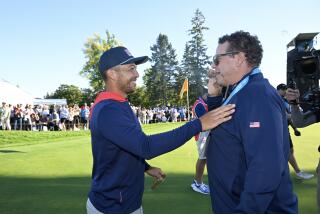There’s Little Rough in These Predictions
- Share via
SUTTON COLDFIELD, England — They’ve played the Ryder Cup 33 times since 1927 and it wasn’t very competitive until the composition of the teams was fundamentally changed. The U.S. was 19-3 against Great Britain until 1979, when the opposing team was expanded to include all of Europe.
Since then, the U.S. is 7-4, but it had lost twice in a row until winning the last Ryder Cup in 1999 at the Country Club in Brookline, Mass.
Many are familiar with Samuel Ryder, the golf-playing son of a corn merchant from Manchester, England. There is no suitable explanation to account for the dramatic leap from selling kernels of corn to selling international amateur golf competition, just go with it.
The Ryder Cup trophy itself is only nine inches wide, from handle to handle, and is 17 inches tall. It looks like something you could chill wine in. The small figure on top of the trophy is Abe Mitchell, who in addition to being Ryder’s friend, was also his golf teacher and a player on three Ryder Cup teams.
So after Ryder got some money behind it, the event took off and Sam got to see two of them played on his home soil.
When Ryder died in 1936 at 77, he was buried with his five-iron. It was probably fortunate they hadn’t invented golf carts yet.
Ryder’s vision for the Ryder Cup was that it become a “small, friendly lunch party.”
These days, it’s a whole new ballgame. But that doesn’t mean there aren’t some Ryder Cup factors you can count on.
In fact, you could make a list of them and check them off one by one when they happen this weekend at the Belfry. No fair saying it’s going to rain. That’s way too easy.
So here’s the list:
10 Sure Things
at the Ryder Cup
1. The clothes the players wear will be blown up into a big issue. Look for the Europeans to stick with shades of brown and black and the U.S. players to wear so much red, white and blue, you won’t know whether to salute them or run them up the flagpole.
2. Somebody is going to figure out that there are way too many names given to the site of the matches and it’s best to leave a few of them on the cutting room floor. For instance, this is how the name of the course is written on the dais in the media interview room: “The De Vere Belfry, Sutton Coldfield, North Warwickshire, England.” Presumably, all they left out was Europe, Northern Hemisphere, Earth, Milky Way Galaxy.
3. The Philip Walton-Howard Clark Factor. Who will it be this time? This is pretty much a European phenomenon, the transformation of a virtually nondescript player, whose main function is to even out the rows on the team picture, into a hero for an instant. Walton and Clark? Didn’t they discover the Northwest Passage? No, Walton and Clark won their singles matches on the last day at Oak Hill in 1995, the two points Europe needed to win, 14 1/2--13 1/2. Neither are in the pro game anymore. Early favorite to embody the Walton-Clark Factor: Phillip Price, who has missed four cuts in his last seven tournaments.
4. Something bizarre will happen at the 10th hole, a par-four. It’s measured at 311 yards but may play longer because new tees have been built, back and to the right. It’s 262 yards to the front of the green, but because the tee has been relocated, trees affect the line to the hole and virtually every player in the field will lay up ... or maybe not. Tiger Woods drove the hole with a three-wood in a practice round. Not one player on either side likes the change, mostly because it was a perfect match-play hole, with water front and to the left, with any score from a two to a six possible. Why was it changed? Speculation centers around Sam Torrance, who wanted to make up an obvious advantage held by the United States’ longer hitters.
5. Someone will heckle Scott Hoch, whose face will turn crimson.
6. No one will heckle Colin Montgomerie, whose face is naturally crimson.
7. Europe will take an early lead Friday and Saturday, and the U.S. will be trailing, thus forced to come from behind when the deciding singles matches begin Sunday.
8. Someone will fail in his attempt to surpass the verbal accomplishments of Jim Furyk, who managed to use the words “ultimate,” “pressure,” “microscope” and “pinnacle” in an introductory clause.
9. Someone will complain about slow play. For the first time, there is no practice putting permitted at the end of a hole. Even though there is a policy against slow play in effect (three “bad times” result in the loss of a hole), someone, let’s say Bernhard Langer, is going to run afoul of the law. It will cause a big stink and strain the good will between captains Curtis Strange and Torrance. In the end, all sides will again agree to play faster, if not better.
10. Civility will win out, the opposite of what happened at Brookline. As Davis Love III said, “I think aside from a few, isolated drunk fans, the Ryder Cup has been excellent.”
Of course, we’ll see about that. But you’ve been warned.
More to Read
Go beyond the scoreboard
Get the latest on L.A.'s teams in the daily Sports Report newsletter.
You may occasionally receive promotional content from the Los Angeles Times.










